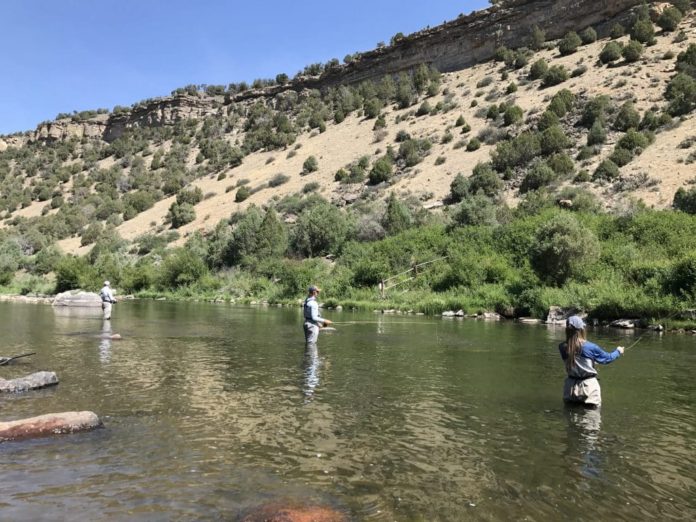Michael Salomone/Courtesy photo
The water levels are dropping. Soon the Eagle River will be a wade fishing-only river. But anglers on their feet are already looking across the river. It always looks nice on the other side. For the adventurous anglers who will be pushing the limits of their waders a review of safe wading procedures is a good idea.
The best way to go about wading safely is to have another angler with you. Don’t go solo on days when you might push the limits of your wading ability. Anglers who fish together can begin to venture farther.

Michael Salomone/Courtesy photo
Partner anglers can team up to wade safely across the river. Locking arms, holding onto each other’s vest or gripping the other angler’s wading belt helps to lift, balance and assist each other safely.
Anglers should assist each other when crossing in areas that are known. Shallow water, broad river stretches and sections with reduced flow are the crossing spots to target. Angle downstream when crossing. Don’t force yourself to cross directly straight across. Angle downstream to maintain balance and footing. The river will help you cross in this situation.
If you must go solo or find yourself too far away from your partner, some type of wading staff is the best help you can find. Whether it is a sturdy piece of driftwood on the bank or a state of the art wading staff use something. Don’t try to cross in water that gets too deep. Anglers can find themselves in a dangerous situation quickly in moderately high water.
There is better wade fishing to come. Water levels will drop into some really good flows giving the confident wading angler and edge in their fishing. Successful trips come from good fishing and great scenery but also by returning safely too.
Proper wading gear is a necessity for safe wade fishing, especially in the waning high water. All wading anglers should wear a waist belt/wading belt of some kind. Waders without a belt become entrapment hazards should the waders fill with water. The heavy waders will pull an angler down into deeper water or drag the angler through fast rocky sections. Waders full of water make it extremely difficult to stand back up while wearing.

Michael Salomone/Courtesy photo
The best bet is to crawl out onto the bank if possible and employ the quick-release buckles most wader makers use. Let the waders drop down around you, dumping the excess water in the process. If a belt has been used a very minimal amount of water will make it down into your legs.
Boots are a key component for safe wading. A secure sole gives anglers the traction they need to cross the river. Steel studs are a great asset for wading but are awful for anything else like hopping in a boat or walking into your fly shop for some last minute flies. Some boots have developed a special rubber to grip and hold even when wet. Felt has fallen out of fashion but is still a viable option for safer wade fishing.
A collapsible wading staff is a quick draw tool to maintain balance and direction. Worn on your wading belt a folding staff can be accessed in a hurry and is always at the ready. I’ve found myself in sticky situations, mid-river, where turning around is a dangerous task. My folding wading staff from Simms was easy to fold out, secure the length and complete my crossing.
Wading anglers don’t wear life jackets. Be safe. Try to not put yourself in a compromising situation. A little premeditation can remove the fear encountered when wade fishing in early summertime when water is still at moderately high levels.
Be prepared for the cold water. It can suck the air out of you when it fills your waders, making you gasp. Muscles tighten up more quickly when immersed in cold water. Dexterity is lost rapidly as well. Be safe. Avoid hazards and keep your feet underneath you. There can be a lot to remember but the best thing to take with you for safety when you head to the river is an aware mind.
Credit: Source link






























